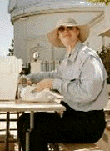|
|
This topic comprises 2 pages: 1 2
|
|
Author
|
Topic: Make-up/Break-down times
|
|
|
|
|
|
|
|
|
|
|
|
|
|
|
|
|
Stephen Furley
Film God

Posts: 3059
From: Coulsdon, Croydon, England
Registered: May 2002
|
 posted 10-15-2005 04:52 AM
posted 10-15-2005 04:52 AM




I've never used a platter, and never handled a new print of a feature, but to make up onto 6ks generally takes me about half the running time. It depends on how the print arrives, whether head or tail out, or a mixture of the two, whether I have a second rewind bench available, how much muck there is to be cleaned off the ends of the reels before re-splicing, etc. I had one recently which took me almost four hours, I think that's the worst I've ever had for a normal film. Spending five minutes preparing each pair of reel-ends, i.e. removing multiple layers of old tape, sticky labels, general muck etc. is not unusual. In that case there's no way I'm going to get it done in an hour.
To break down a print, generally abut half an hour.
| IP: Logged
|
|
Michael Cunningham
Expert Film Handler
Posts: 186
From: Anchorage, AK
Registered: Nov 1999
|
 posted 10-15-2005 09:48 AM
posted 10-15-2005 09:48 AM




Wow, you guys are fast. I usualy build-up, including trailers, cues, junk tail / lable, etc. in an hour and a half. This is building onto 6000's on a rewind bench, reversing, then loading. Of course, I've never worked in a theatre where I didn't have to be threading and starting at the same time, so maybe that has something to do with it. Break-down takes about a half hour.
| IP: Logged
|
|
|
|
Scott Norwood
Film God

Posts: 8146
From: Boston, MA. USA (1774.21 miles northeast of Dallas)
Registered: Jun 99
|
 posted 10-15-2005 11:20 AM
posted 10-15-2005 11:20 AM





For me, it depends on the condition of the print, the amount of other stuff that needs to be done at the same time, and whether I am making up/breaking down to/from a platter (via 6000' reels), 6000' reels, or 2000' reels. The length of the film is also a factor.
In most cases, inspection and makeup takes me about an hour. If there are trailers, it might take longer. It actually takes slightly more time to makeup for projection on 2000' reels (compared with platter or 6000' reels), since I need to measure the cues and also like to label the heads and tails of each reel. On the other hand, the film can go on screen as soon as the first reel is inspected.
Breakdown from a platter takes me about 30 minutes for a standard length (5-7 reels) feature. I usually remove any trailers prior to the last show and break those down on the bench as the show runs. It takes slightly longer when a film ships on cores, since each reel has to be rewound onto a core after being broken down from a platter.
When running 2000' reels, I usually take up directly onto shipping reels (unless they are in bad condition), and "breakdown" takes about 30 seconds after the show ends. With 6000' reels, I usually run the last reel on a 2000' reel, so that everything else can be broken down by the time the show ends. I do then rewind that last reel so that everything is heads out.
In any case, I wouldn't put too much emphasis on makeup and breakdown times, although it's nice to know that I can tell a manager that the film that ends at 9:30 will be ready for pickup at 10:00, or that the print that is scheduled for a 12:00 show will need to arrive no later than 11:00 in order for the show to start on time (assuming a platter house).
| IP: Logged
|
|
|
|
|
|
Jon Miller
Jedi Master Film Handler

Posts: 973
From: San Diego, CA, USA
Registered: Sep 1999
|
 posted 10-15-2005 02:38 PM
posted 10-15-2005 02:38 PM




When it comes to making up and breaking down prints, I'm a tortoise: about an hour to an hour and a half per print to make up, and about 45 minutes to an hour per print to break down.
There's a catch...all prints I handle in my film-festival work are inspected and spliced onto 6000-foot reels using a Kelmar inspection bench; the 6Ks are then rewound and transferred to the platter. Most prints I work with come on cores, and more often than not I find heads and tails spliced on with layers of low-quality tape. The bench inspection process is inherently time-consuming, as is peeling off old splicing tape and cleaning off adhesive residue from the film ends with a rag dampened in Film-Guard.
After the showing, I offload the print from the platter onto 6Ks, then bench-wind each reel back onto the cores to ensure a tight, flat wind. All spices are peeled, never torn.
Sometimes I feel like I'm wasting time, but the satisfaction of doing the right thing more than makes up for the additonal time spent.
| IP: Logged
|
|
|
|
All times are Central (GMT -6:00)
|
This topic comprises 2 pages: 1 2
|
Powered by Infopop Corporation
UBB.classicTM
6.3.1.2
The Film-Tech Forums are designed for various members related to the cinema industry to express their opinions, viewpoints and testimonials on various products, services and events based upon speculation, personal knowledge and factual information through use, therefore all views represented here allow no liability upon the publishers of this web site and the owners of said views assume no liability for any ill will resulting from these postings. The posts made here are for educational as well as entertainment purposes and as such anyone viewing this portion of the website must accept these views as statements of the author of that opinion
and agrees to release the authors from any and all liability.
|

 Home
Home
 Products
Products
 Store
Store
 Forum
Forum
 Warehouse
Warehouse
 Contact Us
Contact Us




 Printer-friendly view of this topic
Printer-friendly view of this topic






![[beer]](graemlins/beer.gif) ) This was probably 3 years ago.
) This was probably 3 years ago. ![[Roll Eyes]](rolleyes.gif)

![[Wink]](wink.gif)

![[Big Grin]](biggrin.gif) ) in about 10 minutes.
) in about 10 minutes.
![[Smile]](smile.gif)








